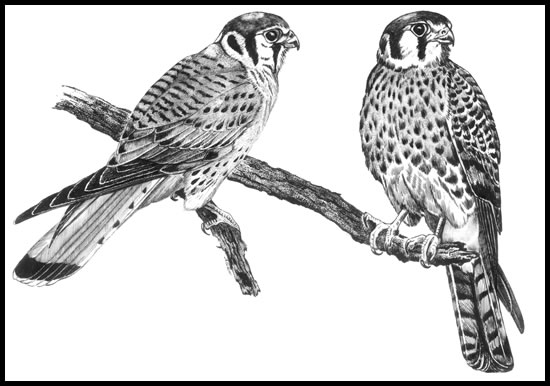| |
| |
| |
| |
| |
| |
| |
| |
| |
| |
 |
| The American kestrel is sometimes
called by the older name of "sparrow hawk." However, this bird
is a true falcon, not a hawk, and while it may hunt sparrows, especially
in the wintertime, its prey is more apt to be insects and rodents. So
scientists and birdwatchers now use the name "American kestrel"
for the smallest falcon found in North America. Related kestrels live
in Europe, Asia, Africa, India and Australia. The American kestrel is about the size of a robin. This little falcon averages 9 inches in length for males, 10 inches in length for females, with a wingspan that averages 21 inches for males, 22 inches for females. Weights average 3.8 ounces for males and 4.3 ounces for the larger females. Among birds of prey the female is almost always larger than the male, so in that way the kestrel is not unusual. However, in coloration it is unusual, because the male and female are differently colored. With most birds of prey there is either no color difference between the sexes, or the difference is very slight. Male American kestrels are vividly colored and patterned, clearly different from the more camouflaged females. A male American kestrel has a rusty-red back and tail, contrasting with denim-blue shoulders and black wing feathers. His underwings are checkered black and white, and his outer tail feathers are boldly striped in differing amounts of black and white (each bird's tail is striped somewhat differently, which is one way kestrels recognize each other). This easy-to-see black and white pattern is used as a signal to warn other kestrels away from the male's territory. The females are an overall rusty-red, with dark brown stripes on the back and tail. Both males and females have two black stripes on their white cheeks, which help to protect these hunters' eyes from glare. Both male and female have dark brown eyes, which are a characteristic of falcons of all ages. The kestrel is North America's most common falcon, as well as its smallest. Its summer diet is made up mostly of large insects like crickets, grasshoppers, cicadas and dragonflies as well as small mammals like mice, voles and shrews. Other prey items are songbirds, snakes, frogs and even the occasional bat. In the wintertime more songbirds appear on the menu. Kestrels from southern Canada, the northern limit of the species' breeding range, migrate in winter, traveling as far as Central America. More southern birds tend to be year-round residents. The kestrel's breeding range extends from Alaska and Canada through all of South America (with the exception of the Amazon rain forest). This little falcon commonly uses two different hunting methods. It may still-hunt from a perch such as a fence post, utility pole or telephone wire. Once perched, the kestrel often bobs its tail up and down, a characteristic of this species that can be seen some distance away. Another common hunting method, a highly visible one, is to hover over an open area on rapidly beating wings, watching for the movement of prey in the grass below. Kestrels have also been seen on the ground after a rain, energetically harvesting earthworms on foot. This can be a noisy little bird, particularly during breeding season. Its most commonly heard call is a high-pitched, rapid KEE-KEE-KEE. The penetrating call and the kestrel's preference for open areas help to make it one of our easiest raptors to observe. Favorite habitats are farm fields, but this falcon can also be seen in cities and towns, hunting over open spaces such as airports, golf courses, vacant lots and even median strips. The kestrel does not build a nest, but lays its four or five eggs in a cavity of some type. It will accept a man-made nesting box. |